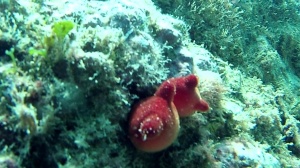Ascidia - Ascidiacea
Ascidia mentula
Red Sea Squirt - Halocynthia papillosa
Ascidiacea (commonly known as the ascidians or sea squirts) is a paraphyletic class in the subphylum Tunicata of sac-like marine invertebrate filter feeders. Ascidians are characterized by a tough outer “tunic” made of the polysaccharide cellulose. Ascidiacea ascidians sea squirts Ascidia intotheblue.it

Description
Ascidians are found all over the world, usually in shallow water with salinities over 2.5%. While members of the Thaliacea and Larvacea (Appendicularia) swim freely like plankton, sea squirts are sessile animals: they remain firmly attached to their substratum, such as rocks and shells.
There are 2,300 species of ascidians and three main types: solitary ascidians, social ascidians that form clumped communities by attaching at their bases, and compound ascidians that consist of many small individuals (each individual is called a zooid) forming colonies up to several meters in diameter.
Sea squirts feed by taking in water through a tube, the oral siphon. The water enters the mouth and pharynx, flows through mucus-covered gill slits (also called pharyngeal stigmata) into a water chamber called the atrium, then exits through the atrial siphon.

Ecology
A sea squirt (Polycarpa aurata) being used as a substrate for a nudibranch‘s (Nembrotha lineolata) egg spiral
The exceptional filtering capability of adult sea squirts causes them to accumulate pollutants that may be toxic to embryos and larvae as well as impede enzyme function in adult tissues. This property has made some species sensitive indicators of pollution.[12]
Over the last few hundred years, most of the world’s harbors have been invaded by non-native sea squirts that have clung to ship hulls or to introduced organisms such as oysters and seaweed. Several factors, including quick attainment of sexual maturity, tolerance of a wide range of environments, and a lack of predators, allow sea squirt populations to grow rapidly. Unwanted populations on docks, ship hulls, and farmed shellfish cause significant economic problems, and sea squirt invasions have disrupted the ecosystem of several natural sub-tidal areas by smothering native animal species.
Sea squirts are the natural prey of many animals, including nudibranchs, flatworms, molluscs, rock crabs, sea stars, fish, birds, and sea otters. They are also eaten by humans in many parts of the world, including Japan, Korea, Chile, and Europe (where they are sold under the name “sea violet”). As chemical defenses, many sea squirts intake and maintain an extremely high concentration of vanadium in the blood, have a very low pH of the tunic due to acid in easily ruptured bladder cells, and (or) produce secondary metabolites harmful to predators and invaders.[14] Some of these metabolites are toxic to cells and are of potential use in pharmaceuticals.

Reproduction
Different colonial ascidian species produce sexually derived offspring by one of two dispersal strategies – Colonial species are either broadcast spawners (long-range dispersal) or philopatric (very short-range dispersal). Broadcast spawners release sperm and ova into the water column and fertilization occurs near to the parent colonies. Resultant zygotes develop into microscopic larvae that may be carried great distances by oceanic currents. The larvae of sessile forms which survive eventually settle and complete maturation on the substratum- then they may bud asexually to form a colony of zooids.
The picture is more complicated for the philopatrically dispersed ascidians: sperm from a nearby colony (or from a zooid of the same colony) enter the pharyngeal siphon and fertilization takes place within the atrium. Embryos are then brooded within the atrium where embryonic development takes place: this results in macroscopic tadpole-like larvae. When mature, these larvae exit the atrial siphon of the adult and then settle close to the parent colony (often within meters). The combined effect of short sperm range and philopatric larval dispersal results in local population structures of closely related individuals/inbred colonies. Generations of colonies which are restricted in dispersal are thought to accumulate adaptions to local conditions, thereby providing advantages over newcomers.
Trauma or predation often results in fragmentation of a colony into subcolonies. Subsequent zooid replication can lead to coalescence and circulatory fusion of the subcolonies. Closely related colonies which are proximate to each other may also fuse if they coalesce and if they are histocompatible. Ascidians were among the first animals to be able to immunologically recognize self from non-self as a mechanism to prevent unrelated colonies from fusing to them and parasitizing them.
https://en.wikipedia.org/wiki/Ascidiacea http://www.intotheblue.it/2019/04/07/ascidia-viola/ http://www.intotheblue.it/2017/07/22/ascidia/


